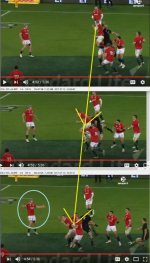- Joined
- Jul 12, 2005
- Messages
- 13,680
- Post Likes
- 1,760
- Current Referee grade:
- Level 2
1. The line-of-touch runs thru the AR, not the thrower, so both Red (at the front) and Black (at the back) are offending.
Err, no.
The AR has his flag down. That means he is no longer marking the LoT because he is satisfied that the Red hooker is ready to throw from the correct place.

You could argue that the Black tailgunner has marginally closed the gap, but the three Red players in the middle are really taking the piss! FFS, one of them is actually standing IN the Black lineout!!!
Now this crap was allowed to go on by all the French referees on this tour. The only only referees who dealt with it correctly were the SANZAR refs; JP in particular told the Lions to stay out of the gap in the line out and to stop talking (and that was another bugbear of mine, the Lions screaming at the referee to hurry up the throw-in) This is behaviour that needs standing on with a size 12 boot!
2. Please show me where 'closing the gap' is referenced in the Laws. I did find:.
I posted it earlier
[LAWS]Law 19.8 Forming a Lineout
(l) Two single straight lines. The lineout players of both teams form two single parallel lines
each at right angles to the touchline.
Sanction: Free Kick on the 15-metre line
(m) Opposing players forming a lineout must keep a clear space between their inside shoulders.
This space is determined when players are in an upright stance.
Sanction: Free Kick on the 15-metre line
Sanction: Free Kick on the 15-metre line[/LAWS]
If you fail to keep the space (or gap) then you are "closing the gap"






